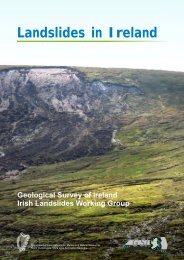Sinkholes Tellus Border Earthquake - Geological Survey of Ireland
Sinkholes Tellus Border Earthquake - Geological Survey of Ireland
Sinkholes Tellus Border Earthquake - Geological Survey of Ireland
Create successful ePaper yourself
Turn your PDF publications into a flip-book with our unique Google optimized e-Paper software.
GSI at the EUROPEAN SPACE EXPO<br />
Michael Sheehy<br />
Geologist, Quaternary and Geotechnical Programme<br />
GSI was a partner to the European<br />
Space Expo when it visited Dublin<br />
from the 4th to the 9th <strong>of</strong> June. This<br />
successful event was hosted in its<br />
own specially constructed dome in<br />
Trinity College Dublin Front Square<br />
and had 30,000 visitors. The<br />
European Space Expo showcased<br />
the wide range <strong>of</strong> benefits that<br />
Space brings to Europe and how<br />
these initiatives are improving<br />
our quality <strong>of</strong> life. GSI contributed<br />
two talks on space applications<br />
focused on how observing the<br />
earth from different vantage points<br />
and in different ways can answer<br />
important geological questions<br />
for Irish, and European, citizens.<br />
Visitors to the Space Expo were<br />
provided with material illustrating<br />
the process <strong>of</strong> combining space<br />
data with geological data and<br />
knowledge.<br />
The role <strong>of</strong> Earth Observation<br />
(EO) data in mapping <strong>Ireland</strong>'s<br />
maritime territory, one <strong>of</strong> the<br />
largest in Europe was detailed by<br />
GSI Director, Koen Verbruggen.<br />
Director Verbruggen’s overview <strong>of</strong><br />
the contribution EO technologies<br />
make to bathymetric mapping<br />
also illustrated the useful<br />
derivatives that are developed<br />
as ancillary products when using<br />
these technologies. Mapping<br />
the submarine environment and<br />
mapping from space present<br />
similar sets <strong>of</strong> challenges; Director<br />
Verbruggen also described some<br />
<strong>of</strong> these parallels, how obstacles<br />
are overcome to achieve good<br />
outcomes and anticipated future<br />
directions.<br />
GSI geologist, Michael Sheehy,<br />
engaged the audience when<br />
he demonstrated how radar<br />
data helps map geohazards<br />
(landslides, subsidence, heave)<br />
in urban areas. This talk came<br />
from work developed during<br />
GSI’s participation in the FP7<br />
PanGeo project. The PanGeo<br />
project (www.pangeoproject.eu) is<br />
developing ground instability maps<br />
and reports for 52 large centres <strong>of</strong><br />
population in the EU (~13% <strong>of</strong> the<br />
EU population). PanGeo provides<br />
a ‘ground stability layer’ which<br />
describes the spatial location and<br />
extent <strong>of</strong> geohazards for all the<br />
cities mapped. Geohazards in<br />
each participating city have been<br />
mapped by the corresponding<br />
National <strong>Geological</strong> <strong>Survey</strong>.<br />
Geology Matters: Summer 2013<br />
Michael Sheehy, addressing the audience at the EUROPEAN<br />
SPACE EXPO in Trinity College, Dublin in June 2013.<br />
Photo by @megafloods<br />
Detailed local knowledge <strong>of</strong><br />
geohazards has been combined<br />
with satellite observations <strong>of</strong><br />
ground movement to create<br />
a comprehensive map <strong>of</strong> all<br />
geohazards present in each town,<br />
ensuring that different towns can<br />
be compared. The <strong>Geological</strong><br />
<strong>Survey</strong> <strong>of</strong> <strong>Ireland</strong> has developed<br />
‘ground stability layer’ maps and<br />
interpretive reports for Co. Dublin<br />
and Cork City (the combined study<br />
areas cover >30% <strong>of</strong> the Irish<br />
population).<br />
page 25

















